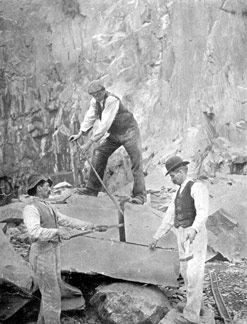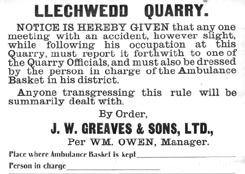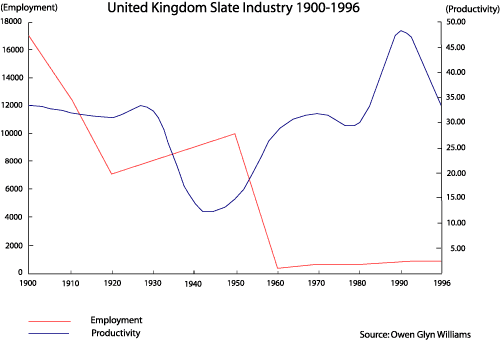The History of Quarrying - The Long
Decline
 It was a severe depression in the building trade in the
1880’s that led to a reduced demand for slates. The 1880’s were
a period of trade depression that affected all walks of life.
Commodity prices fell, and did not rise again until the Great
War. Coupled to this severe depression were industrial disputes.
Cut-throat competition as well as the depressed state of trade
subsequently led to the closing of many of the smaller quarries,
while some were taken over by the larger ones. Added to all this
were the imposition of duties on foreign slates by some countries
like France and Switzerland. A downturn in sales to Germany hit the Ffestiniog area
especially. 39,000 tons were exported from Porthmadog to Germany
in 1894, 21,000 tons in 1901 and only 11,000 in 1910. Between
1889 and 1918 the quantity of exported slates in general fell
from 79,912 tons to 1,592 tons. It was a severe depression in the building trade in the
1880’s that led to a reduced demand for slates. The 1880’s were
a period of trade depression that affected all walks of life.
Commodity prices fell, and did not rise again until the Great
War. Coupled to this severe depression were industrial disputes.
Cut-throat competition as well as the depressed state of trade
subsequently led to the closing of many of the smaller quarries,
while some were taken over by the larger ones. Added to all this
were the imposition of duties on foreign slates by some countries
like France and Switzerland. A downturn in sales to Germany hit the Ffestiniog area
especially. 39,000 tons were exported from Porthmadog to Germany
in 1894, 21,000 tons in 1901 and only 11,000 in 1910. Between
1889 and 1918 the quantity of exported slates in general fell
from 79,912 tons to 1,592 tons.
The home market did not decline so dramatically. With
slum clearance policies being undertaken in Scottish and English
cities in the 1890’s, demand for slates for new building
increased. However, Irish exports declined especially after the
Home Rule Agitation in 1893. Contributing to the slow decline
were the imports of cheap slate into Scotland, England, and even
Wales from such countries as Holland, Turkey, Canada, Norway,
Portugal, Belgium, France and the USA.
Another blow to the industry was the discouragement given by
the English Board of Education to the use of writing slates in
schools.
By 1906-08, Welsh slate was piling up at the quaysides at
Porthmadog, Caernarfon and Felinheli and more and more families
in the slate producing areas were driven into debt.
War, Depression & Another War
 The Great War saw the closure of
quarries, others going on a three-day week and unemployment
soaring. In 1917, slate quarrying was declared a non-essential
industry. The Great War saw the closure of
quarries, others going on a three-day week and unemployment
soaring. In 1917, slate quarrying was declared a non-essential
industry.
Following the cessation of hostilities, there was an urgent
demand for houses to provide ‘homes for heroes to live
in.’
The trend towards amalgamation accelerated. Dividends had
fallen before 1914 and many quarries continued to make loss into
the 1920’s and 1930’s. Roofing tiles were used more and more by
the building industry after 1924, and where slates were used,
they would tend to be the cheap foreign variety. The 1930’s saw a
period of building expansion, but saw no comparable increase in
slate production. Quarries in north Wales produced 364,000 tons
of slate in 1912 compared to 271,000 tons in 1935. The production
of roofing tiles in 1935 was estimated at 1,200,000 tons.
With the outbreak of war yet again in 1939 and the strict
control on new building, the demand for slate fell yet again. By
1940, around 4,600 men had left the industry, with around half of
them joining the forces. True, the bombing of towns and cities
created an urgent demand for roofing slates, but labour was short
and the reserves of readily useable slate had all been used up.
Furthermore, the number of apprenticeships declined from 735 in
1939 to 183 in 1946. The slate industry could not meet the
challenge and many quarries were forced to close, some for
good.
 The number of workers reflects the
speed of this decline. In 1939, that number was 7,589. By 1945,
this number had fallen to 3,520, and in 1972 it was less than
1,000. A five day week was introduced for the first time in the
industry in 1947, with the work hours at most quarries from 7am
to 5pm, while at Penrhyn a 40 hour week was introduced. Even
though an order was given that all the slate produced could go to
the repair of war-damaged houses, there was a severe shortage of
skilled labour, especially rock men and miners. This also meant
that the average age of the workers increased. Nationalisation
was considered in 1949 and this undermined the confidence of some
proprietors. The number of workers reflects the
speed of this decline. In 1939, that number was 7,589. By 1945,
this number had fallen to 3,520, and in 1972 it was less than
1,000. A five day week was introduced for the first time in the
industry in 1947, with the work hours at most quarries from 7am
to 5pm, while at Penrhyn a 40 hour week was introduced. Even
though an order was given that all the slate produced could go to
the repair of war-damaged houses, there was a severe shortage of
skilled labour, especially rock men and miners. This also meant
that the average age of the workers increased. Nationalisation
was considered in 1949 and this undermined the confidence of some
proprietors.
But the main problem was that the price of slate was so high
compared to asbestos, clay or tiles, especially concrete tiles.
The imports of poorer quality foreign slates declined. Modern
machinery was put in to increase output and become more cost
efficient. But the decline of the whole Welsh Slate Industry
could not be halted.
| Year |
|
Tons |
| 1958 |
|
54,000 |
| 1959 |
|
46,000 |
| 1960 |
|
52,000 |
| 1961 |
|
45,000 |
| 1962 |
|
40,000 |
| 1963 |
|
33,000 |
| 1964 |
|
35,000 |
| 1965 |
|
37,000 |
| 1966 |
|
35,000 |
| 1967 |
|
39,000 |
| 1968 |
|
32,000 |
| 1969 |
|
24,000 |
| 1970 |
|
22,000 |
The opening of a new quarry at Marchlyn, Llanberis despite the
huge sums invested also proved a failure.

|